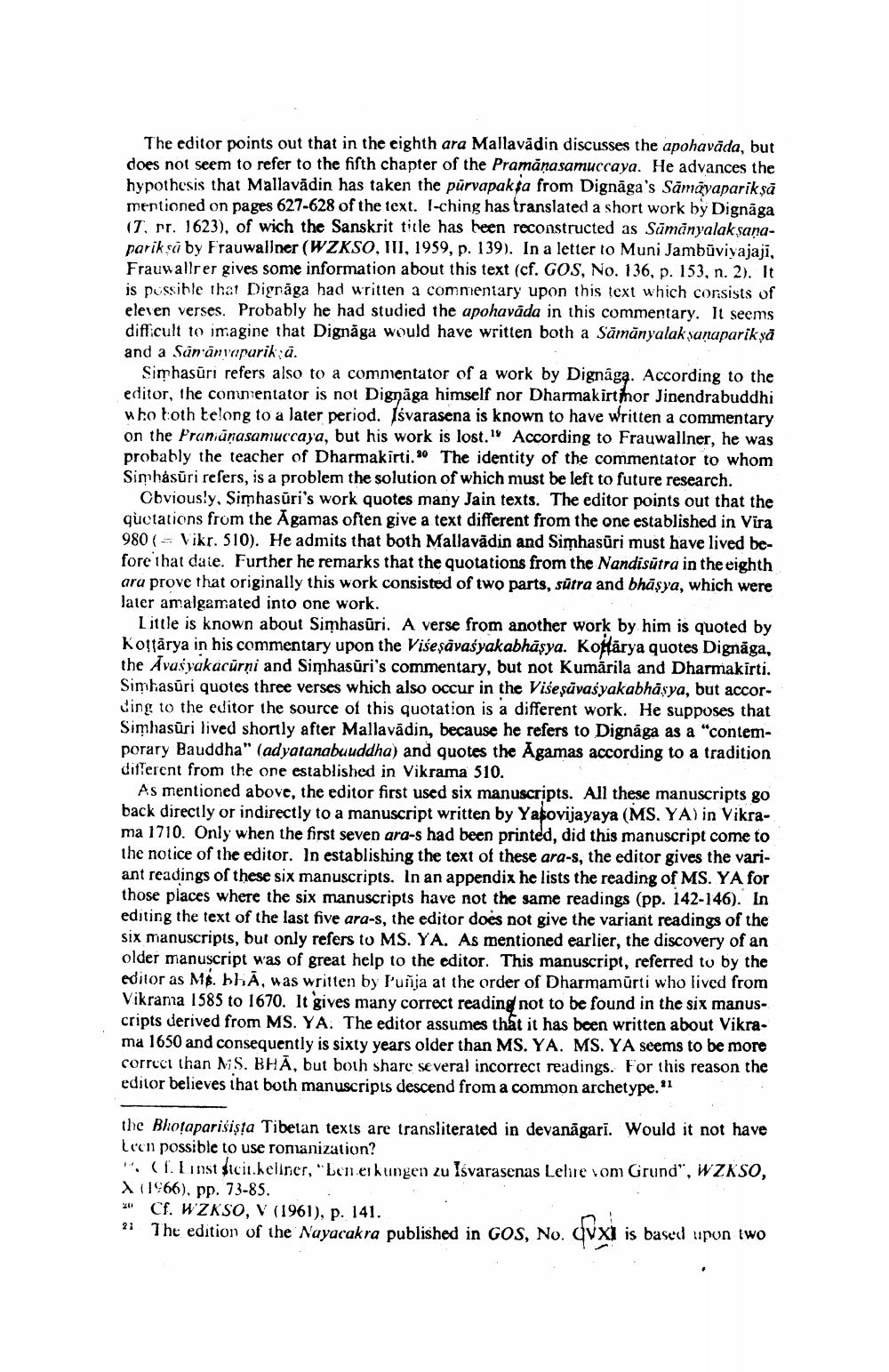Book Title: Nyayachakra Lekh Author(s): J W De Jong Publisher: J W De Jong View full book textPage 5
________________ The editor points out that in the eighth ara Mallavādin discusses the apohavāda, but does not seem to refer to the fifth chapter of the Pramānasamuccaya. He advances the hypothesis that Mallavādin has taken the purvapak$a from Dignāga's Sāmāyaparik şā mentioned on pages 627-628 of the text. l-ching has translated a short work by Dignaga 07. nr. 1623), of wich the Sanskrit title has been reconstructed as Samanyalak saņapariksa by Frauwallner (WZKSO, II, 1959, p. 139). In a letter to Muni Jambūvivajaji, Frauuallrer gives some information about this text (cf. GOS, No. 136, p. 153, n. 2). It is possible that Digråga had written a commentary upon this text which corsists of eleven verses. Probably he had studied the apohavāda in this commentary. It seems difficult to imagine that Dignāga would have written both a Sāmānyalak sanaparikșă and a San antararik à. Simhasūri refers also to a commentator of a work by Dignāga. According to the editor, the commentator is not Dignāga himself nor Dharmakirt for Jinendrabuddhi who both telong to a later period. Isvarasena is known to have written a commentary on the Praniūnasamuccaya, but his work is lost." According to Frauwallner, he was probably the teacher of Dharmakirti.* The identity of the commentator to whom Simhásūri refers, is a problem the solution of which must be left to future research. Obviously, Şimhasūri's work quotes many Jain texts. The editor points out that the quctations from the Agamas often give a text different from the one established in Vira 980(- Vikr. 510). He admits that both Mallavādin and Simhasūri must have lived before that date. Further he remarks that the quotations from the Nandisutra in the eighth ara prove that originally this work consisted of two parts, sutra and bhāşya, which were later amalgamated into one work. Little is known about Simhasūri. A verse from another work by him is quoted by Kostărya in his commentary upon the Višeşāvasyakabhāsya. Koffárya quotes Dignāga, the Avas yakacūrņi and Simhasūri's commentary, but not Kumarila and Dharmakirti. Simhasūri quotes three verses which also occur in the Višeşūvašyakabhâsya, but according to the editor the source of this quotation is a different work. He supposes that Simhasūri lived shortly after Mallavadin, because he refers to Dignaga as a "contemporary Bauddha" (adyatanabuuddha) and quotes the Agamas according to a tradition different from the one established in Vikrama 510. As mentioned above, the editor first used six manuscripts. All these manuscripts go back directly or indirectly to a manuscript written by Yabovijayaya (MS. YA) in Vikrama 1710. Only when the first seven ara-s had been printed, did this manuscript come to the notice of the editor. In establishing the text of these ara-s, the editor gives the variant readings of these six manuscripts. In an appendix he lists the reading of MS. YA for those places where the six manuscripts have not the same readings (pp. 142-146). In editing the text of the last five ara-s, the editor does not give the variant readings of the six manuscripts, but only refers to MS. YA. As mentioned earlier, the discovery of an older manuscript was of great help to the editor. This manuscript, referred to by the editor as Ms. bhĀ, was written by Puña at the order of Dharmamurti who lived from Vikrana 1585 to 1670. It gives many correct reading not to be found in the six manuscripts derived from MS. YA. The editor assumes that it has been written about Vikrama 1650 and consequently is sixty years older than MS. YA. MS. YA seems to be more correct than MS. BHA, but both share several incorrect readings. For this reason the editor believes ihat both manuscripts descend from a common archetype. "1 the Bhotaparisista Tibetan texts are transliterated in devanāgari. Would it not have Leon possible to use romanization? " (1. Linst sicikeliner, 'enerkungen zu Isvarasenas Lehre vom Grund", W ZKSO, (1966), pp. 73-85. 24 Cf. WZKSO, V (1961), p. 141. 21 The edition of the Nayacakra published in GOS is based upon twoPage Navigation
1 ... 3 4 5 6
